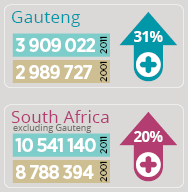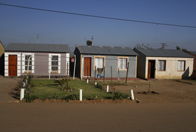The history of human settlement in the GCR provides an interesting view of the challenges facing future growth and development. Historical perceptions of opportunity held by migrants have attracted people to its cities since the mid-nineteenth century.
Interrogating how human settlement has occurred in the GCR over time and identifying the various forms of housing utilised by the region's residents can present a clear picture of the extent of difference within the region, the challenges facing future growth and development, and importantly the impact of household growth on the number and quality of houses built, their locations and configurations.
| Change in housing type** |
2001 |
2011 |
| House or brick structure on a separate stand or yard |
1 522 551 |
2 307 843 |
| Traditional dwelling/hut/structure made of traditional materials |
36 934 |
13 723 |
| Flat in block of flats |
188 666 |
280 396 |
| Town/cluster/semi-detached house (simplex; duplex; triplex) |
125 255 |
268 722 |
| House/flat/room in backyard |
197 591 |
219 103 |
| Informal dwelling/shack in backyard |
192 613 |
305 683 |
| Informal dwelling/shack NOT in backyard |
475 840 |
434 075 |
| Room/flatlet not in backyard but on shared property |
43 285 |
45 032 |
| Caravan or tent |
7 363 |
2 905 |
| Not applicable (living quarters is not housing unit) |
199 630 |
31 539 |
| Total |
2 985 727 |
3 909 022 |
This table demonstrates an increase in formal single houses. Most notably however are the near double increase in cluster/ townhouse households and the significant increase in informal backyard housing which shows a trend towards densification in the province (Quantec Census 2011).







